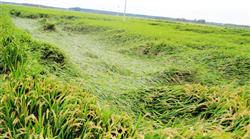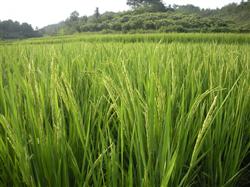How to prevent lodging and grass damage in rice?

How to prevent lodging and grass damage in rice? Please introduce the control methods of rice, which are easy to lodging and vulnerable to grass damage. The following countermeasures should be taken: to select the right varieties and choose direct seeding rice varieties should not only have high quality, high yield and multi-resistance, but also have the characteristics of fertilizer tolerance, dwarfing and medium tillering. Mid-maturing varieties should be selected for early rice, and direct seeding of early-maturing varieties should be avoided to further shorten the growth period, resulting in low yield. The fertilization principle of direct seeding rice is "controlling nitrogen, combining phosphorus and increasing potassium", "forefoot, middle control and post supplement", and the fertilization method should be "one base and three topdressing". Base fertilizer accounts for 40% of the amount of fertilizer applied, and topdressing accounts for 60%. The nitrogen fertilizer should be half of the base fertilizer and topdressing, and the basic application of phosphorus fertilizer, especially the potash fertilizer should be applied in the second topdressing, and the effect of lodging resistance is more significant. There are many tillers and large population of direct seeding rice in advance, so it is necessary to leave the field early, reduce invalid tillers, increase panicle rate, promote root rooting and prevent lodging. The field begins to be shelved when the tiller seedlings in the field reach 80% of the expected number of ears. As the root distribution of direct seeding rice is shallow, it is appropriate to put it lightly for many times to make the root system gradually deep. The chemical regulation was controlled by paclobutrazol once at the end of tillering stage and the early stage of break of direct seeding rice, which had a significant effect on controlling length, preventing inversion and increasing grain weight. In rice jointing stage, the effect of lodging prevention was also obvious when uniconazole and potassium fertilizer were applied together. Weed control is the key to high yield of direct seeding rice. We should adhere to the principle of "except the early, the small and the small". Before sowing, 10% glyphosate 1kg was used for large fields with more weeds, and water 50kg was added to spray 7-10 days before sowing and when there was no water in the field on a sunny day, or 7 days before sowing, after preparing the field, irrigated with water about 3.3cm, and then sprayed with 60% butachlor 100ml and water every 667m2. From the day of sowing valley collapse to the third day, 17.2% Xiaohebao wet powder 200g can be used to spray water, or 3-5 days after sowing, 30% fluorine EC 100ml can be sprayed evenly every 667 square meters. In the fields with more broad-leaf weeds from the fifth leaf to the late tillering stage of direct seeding rice, the field water should be drained, and then 20% dimethyl tetrachloride 200ml plus water 50kg should be sprayed every 677 square meters. 4cm-5cm was irrigated every other day and dried naturally after 7-10 days. Click to get more rice planting techniques click to get more food crop planting techniques
- Prev

Why does rice lodge? How to prevent and cure it?
Why does rice lodge? How to prevent and cure it? Please introduce that the earlier the rice lodging occurs, the greater the impact on the yield, the serious plots can reduce the yield by more than 50%, or even cause no harvest. Lodging also has a great impact on rice quality, but also increases the difficulty of harvest. Although rice lodging is related to windy and rainy weather, but the main.
- Next

What should rice heading stage medication pay attention to?
What should rice heading stage medication pay attention to? Please give a detailed description of rice before and after heading is generally the occurrence of a variety of diseases and insect pests, need to use chemical pesticides control, but in this growth period, some pesticides are very easy to cause drug damage, resulting in unnecessary losses, should be paid attention to. One, triazole.
Related
- The first cup of black tea in spring, the flavor and history of tea gardens in Kenya, Africa
- The computer can not only choose potatoes, but also grow tea rice. AI will grow winter oolong tea champion.
- It is not only the inflated tea bitten by insects, but also engraved with the four seasons tea in Beipu.
- The Oriental Beauty Tea Festival in Zhuxian County takes the stage at the weekend to experience the plus-size feast of oil tea.
- & quot; Oriental Beauty Tea & Exploration of Emei in Hsinchu, the hometown of quot;
- The new variety of strawberry "Tainong 1" dessert is the first choice with mellow aroma. Crimson gorgeous
- History of Tea in Taiwan: from Wild Inner Mountain to Export Tea Garden
- Two types of Taiwan Oriental Beauty Black Tea won the British three-Star Award for Childhood Tea Xiang Zhang Jiaqi changed from pilot to champion tea maker.
- Banana species and varieties: the planting history of Taiwan Xianren banana and dwarf banana is long, is banana disease resistant?
- Coffee planting Technology: Qianjie Coffee from Seedling to harvesting

